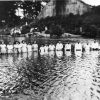calsfoundation@cals.org
Elijah (Eli) Lindsey (1797–1834)
The Reverend Elijah (Eli) Lindsey was an important figure in early Arkansas Methodism. At age eighteen, living near the present town of Jesup (Lawrence County), he traveled and organized the Spring River Circuit and is thus celebrated as the first to preach and spread the message of Methodism in Arkansas.
Eli Lindsey was born in 1797 in Rutherford County, North Carolina, to James William Lindsey Jr. and Rachel Burkett Lindsey. His father fought with the patriots at the significant Battle of Kings Mountain on October 7, 1780. By 1790, these families had moved to Spartanburg County, South Carolina, and they resided in Rutherford County, North Carolina, by 1800. Lindsey’s family gradually moved to Christian County, Kentucky, where his uncle Carlton died. His uncles Joshua and Micajah died in Mississippi, and James Jr. and Caleb settled in Lawrence County in Arkansas Territory by 1814.
In a common classroom in a cave in Lawrence County, Lindsey, his siblings, his cousins, and neighbor children received a classical education from his uncle Caleb Lindsey (1767–1826); the only textbooks were the Bible and classics such as works by Homer and Shakespeare.
James Anderson wrote of Lindsey in his 1935 Centennial History of Arkansas Methodism, stating, “His is the glory of having organized the first Methodist work in this State. This heroic man ranged from Little Red River near where Searcy and Judsonia now stand, to the Missouri line, and that with no thought of compensation. Let his name be enshrined in our memories.” In addition to his farming endeavors, Lindsey had other duties. In 1824, he was appointed adjutant of the Third Regiment of the Lawrence County Militia and magistrate of Union Township. By this time, Lindsey had a wife and son, having married Maria Williams, daughter of another prominent pioneer couple, Benjamin Williams and Sarah Battle Williams, natives of Onslow County, North Carolina.
Three definitive works on Arkansas Methodism—written by Horace Jewell in 1892, James Anderson in 1935, and Walter Vernon in 1976—all describe Lindsey’s noteworthy ministry. Josiah Shinn’s 1908 book Pioneers and Makers of Arkansas, although containing errors about the Lindsey family genealogy, also described Lindsey’s activities.
James Anderson repeated an oft-told story about Lindsey that revealed much about his methods and personality. Colonel Morgan Magness related that, during a service Lindsey held at Batesville (Independence County), the dogs scented a bear nearby. The men grabbed their rifles and rushed out with the dogs. After the bear was felled, Lindsey resumed the service, “thanking God for men who could shoot and women who could pray.”
The common dilemma of all sources about Lindsey was that none of the authors knew what had happened to him after his Lawrence County activities. By 1825, Lindsey, his parents, and his five sisters and four brothers had all moved to the area that is now Tull (Grant County), on the edge of Nall Lake. Lindsey performed the occasional marriage, evident in Pulaski County records. Along with other family, he is on the 1830 census of Pulaski County. His parents, his brothers James and Carlton, and three sisters all died of cholera within six weeks of each other in the spring of 1831. In August 1832, Lindsey wrote a letter to fellow Methodist Jesse Greene describing the progress of the local Methodist movement. This remarkable letter reveals Lindsey’s extraordinary level of classical education for his time and place.
On May 2, 1834, “on the Fourche LeFave, Conway county,” Lindsey died of an unknown cause. He is buried in the Williams Cemetery, a recently restored cemetery in the village of Tull. A one-sentence obituary in the Arkansas Gazette mentions that Lindsey was “about age 37.” The stories of “old Eli Lindsey” that followed, years later, were a result of the many years that had passed and not because of his age at death. In 1839, in Saline County, Lindsey’s widow Maria had custody of their five sons and one daughter, “heirs of Eli Lindsey, deceased.”
The Methodist church that now stands in Jesup was erected in 1905, and it was renamed the “Eli Lindsey Memorial Methodist Church” in 1939. In a field nearby, a granite marker erected by the North Arkansas Historical Commission rests on the site of the log house where Lindsey “lived in 1815 and started the work of Methodism in Arkansas.”
For additional information:
Anderson, James A. A Centennial History of Arkansas Methodism. Benton, AR: L. B. White Printing Co., 1935.
Jewell, Horace. History of Methodism in Arkansas. Little Rock: Press Printing Co., 1892.
Shinn, Josiah H. Pioneers and Makers of Arkansas. Little Rock: Democrat Printing and Lithographing Co., 1908.
Vernon, Walter. Methodism in Arkansas, 1816–1976. Little Rock: Joint Commission for the History of Arkansas Methodism, 1976.
Gloria Schouw Reck
Eureka, California
 Louisiana Purchase through Early Statehood, 1803 through 1860
Louisiana Purchase through Early Statehood, 1803 through 1860 Religion
Religion




The article on Eli Lindsey was very well written and true. Eli Lindsey was my great-great-uncle, and I am very proud of all he accomplished.